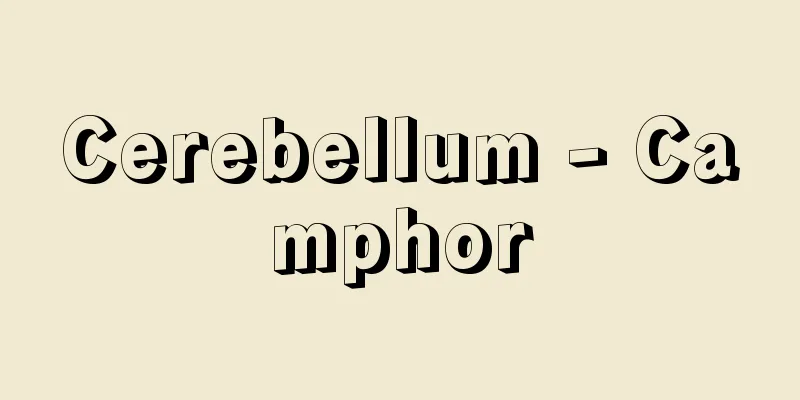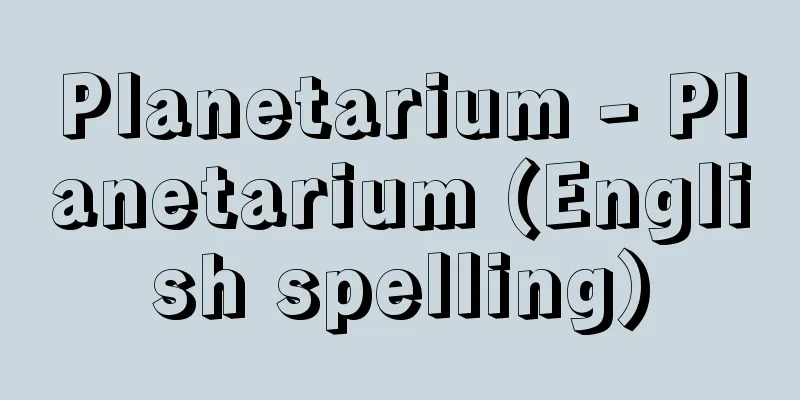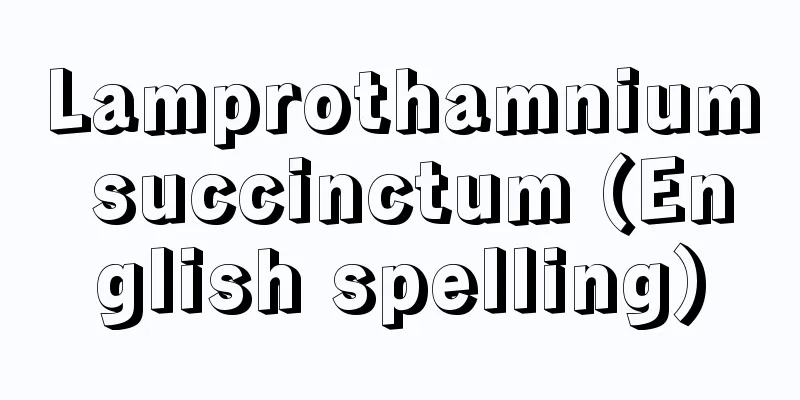Cerebellum - Camphor

|
It is one of the components of the brain of vertebrates. It is the part of the central nervous system (brain and spinal cord) that receives the sense of balance from the inner ear and receives stimuli from the sensory receptors in the muscles, tendons, and joints of the whole body, maintaining muscle tone and regulating muscle movement. It develops from the ectoderm near the anterior end of the fourth ventricle and covers the fourth ventricle from the rear-upper part like a tent. In the hindbrain (cerebellum and pons), it occupies the dorsal part and is housed in the posterior cranial fossa. From a comparative anatomical perspective, the cerebellum of animals that move quickly and perform fine movements is generally well developed, and is well developed in bony fish, birds, and mammals, but is poorly developed and small in amphibians such as toads and newts, and reptiles, which move slowly. The weight of the human cerebellum is approximately 130 to 150 grams. The human cerebellum is somewhat flat on the top, protruding on the bottom, and significantly swollen on both the left and right sides. These swollen parts are the cerebellar hemispheres, and the thin part in the middle is the vermis. On the top, the boundary between the cerebellar hemispheres and the vermis is not clear, but on the bottom, the vermis is deeply recessed, called the cerebelli noria, and contains the medulla oblongata. In the cerebellar vallecula, the boundary between the cerebellar hemispheres and the vermis is clearly defined by a deep groove. On the bottom, there are the cerebellar peduncles, which connect the cerebellum to the rest of the brainstem, and which connect to the medulla oblongata, pons, and midbrain of the brainstem. The cerebellar peduncles are divided into three pairs: upper, middle, and lower. The inferior cerebellar peduncles carry conduction pathways from the spinal cord and medulla oblongata, and the middle cerebellar peduncles connect the cerebellum to the pons. In higher mammals, the pons is particularly well developed, so the middle cerebellar peduncles are thick and clearly visible. The superior cerebellar peduncle is the main area through which conductive pathways pass from the cerebellum to the midbrain and diencephalon. The entire surface of the cerebellum has cerebellar sulci running almost parallel to each other, and the raised wrinkles between these sulci are called cerebellar gyri. Some of the cerebellar sulci are particularly deep, and between them are numerous cerebellar gyri, which together form the cerebellar lobes and divide the surface of the cerebellum. These cerebellar lobes and each part of the cerebellum are named, but all of these names are based on their external shape, so for example, the name of the human cerebellum is only used for humans. When considering the cerebellum as a whole in vertebrates, the vermis and the flocculus on the underside of the cerebellum are an old lineage of cerebellum that is also found in birds and below, while the cerebellar hemispheres are a new lineage of cerebellum that appears only in mammals. The surface layer of the cerebellum is gray matter about 1 millimeter thick, and nerve cells are arranged in it to form the cerebellar cortex. The cerebellar cortex has an extremely expanded surface area by forming wrinkles (microgyri). The cortex has three layers of nerve cells, which receive nerve fibers entering the cerebellum and send nerve fibers from the cerebellum to the midbrain and diencephalon. The third layer, the granule cell layer, is the part of human tissue with the highest cell density. The second layer is characterized by a single layer of extremely unique pear-shaped large cells called Purkinje cells. The center of the cerebellum is the medulla, which is filled with nerve fibers, and in the area close to the fourth ventricle, there are four types of gray matter masses, namely, cerebellar nuclei, which exist in pairs, called the dentate nucleus, the globular nucleus, and the fastigial nucleus. These nuclei receive afferent fibers to the cerebellum and fibers from the Purkinje cells, and send out efferent fibers to the midbrain and diencephalon. The fastigial nucleus is a group of nerve cells related to the vestibular nervous system. If there is an injury to the vermis of the cerebellum, motor disorders related to trunk movement and posture maintenance are observed, and symptoms such as staggering appear. Also, if there is an injury to the cerebellar hemisphere, ataxia of the limbs is observed in the limbs on the affected side. [Kazuyo Shimai] [Reference] | |©Shogakukan "> Location and structure of the cerebellum ©Shogakukan "> The vertebrate brain Source: Shogakukan Encyclopedia Nipponica About Encyclopedia Nipponica Information | Legend |
|
脊椎(せきつい)動物の脳を構成する一要素。中枢神経(脳と脊髄)のうち、内耳から平衡感覚を受け、また全身の筋、腱(けん)、関節などに存在する感覚受容器から刺激を受けて筋肉の緊張を保ち、筋肉運動の調節をつかさどる機能をもつ部分である。第四脳室前端部付近の外胚葉(がいはいよう)から発生し、第四脳室を後上方からテントのように覆っている。後脳(小脳と橋(きょう))では背側部を占め、後頭蓋窩(こうとうがいか)に収容されている。比較解剖学的にみると、運動が敏速で、かつ細かい運動をする動物の小脳は概して発達がよく、硬骨魚類、鳥類、哺乳(ほにゅう)類ではよい発育を示し、緩慢な運動をするヒキガエル、イモリなどの両生類、爬虫(はちゅう)類などでは発育が悪くて小さい。なお、ヒトの小脳の重さは、およそ130~150グラムとされる。 ヒトの小脳は上面が多少扁平(へんぺい)で下面は突出し、左右両側は著しく膨大している。この膨大部が小脳半球で、中央部の細い部分が虫部(ちゅうぶ)である。上面では小脳半球と虫部との境は明瞭(めいりょう)でないが、下面は虫部部分が深く陥没し、ここを小脳谷(こく)とよび、延髄部分が収まっている。小脳谷では小脳半球と虫部とは深い溝で明瞭に境ができている。下面には小脳と他の脳幹部を連絡する小脳脚(きゃく)があり、脳幹部の延髄、橋、中脳と結合している。小脳脚は上、中、下の3対の部分に分けられ、下小脳脚は脊髄、延髄からの伝導路が通り、中小脳脚は小脳と橋とを連絡しており、高等な哺乳動物では、とくに橋の発達がよいので、中小脳脚も太くて外観的にも明瞭である。上小脳脚はおもに小脳から中脳、間脳へと出ていく伝導路が通る部分である。 小脳全表面にはほぼ平行に走る小脳溝(こう)があり、この溝の間のしわの高まりが小脳回である。小脳溝のなかにはとくに深い溝がいくつかあり、その間に多数の小脳回があり、集合して小脳葉を形成し、小脳表面を区分している。これらの小脳葉、あるいは小脳各部には名称がつけられているが、いずれもその外形によっての名称であるため、たとえば、ヒトの小脳の名称はヒトにだけしか通用しないものとなっている。脊椎動物全体として小脳をみた場合、虫部と小脳下面の片葉という部分は鳥類以下にも存在する古い系統の小脳であり、小脳半球は哺乳類になって初めて現れる新しい系統の小脳となっている。小脳表層は厚さ1ミリメートルほどの灰白質で、神経細胞が配列し、小脳皮質を形成している。小脳皮質はしわ(小脳回)を形成することによって表面積を極度に拡張している。皮質には3層の神経細胞層があり、小脳へ入る神経線維を受けるほか、小脳から中脳や間脳へ神経線維を出している。第3層の顆粒(かりゅう)細胞層は人体の組織ではもっとも細胞の分布密度が高い部分である。第2層にはプルキンエ細胞とよぶきわめて特殊な西洋ナシ状の大型細胞が1層に配列しているのが特徴である。小脳の中心部は神経線維が充満する髄質で、第四脳室に近い部位には4種類の灰白質塊、すなわち小脳核が対(つい)をなして存在し、歯状核、栓状核、球状核、室頂核とよぶ。これらの核は小脳への求心性線維やプルキンエ細胞からの線維を受け、中脳、間脳へ遠心性線維を出している。なお、室頂核は前庭神経系と関係する神経細胞群である。小脳の虫部に障害があると躯幹(くかん)の運動や姿勢保持に関係する運動障害がみられ、千鳥足のような症状が現れる。また、小脳半球に障害があると四肢の運動失調が障害側の手足にみられる。 [嶋井和世] [参照項目] | |©Shogakukan"> 小脳の部位と構造 ©Shogakukan"> 脊椎動物の脳 出典 小学館 日本大百科全書(ニッポニカ)日本大百科全書(ニッポニカ)について 情報 | 凡例 |
Recommend
Meadowsweet
…The flowers are usually pale pink, but there are...
Africa Rinsan - Africa Rinsan
…They have large black or dark brown spots, and a...
Collection of Mothers of Jojin Ajari - Collection of Mothers of Jojin Ajari
A literary diary collection from the late Heian p...
Ruins of Muyangcheng - Muyangcheng Ruins (English)
The remains of an ancient castle from the Warring ...
Fidelio - Fidelio (English spelling)
An opera composed by Beethoven. The libretto was ...
Breton, André
Born: February 18, 1896 in Tinchebray, Orne Died S...
Gaussian process
In an m -dimensional stochastic process X ( t ), a...
Alps Experiment - Arupsu Jikken
…The second objective is to thoroughly investigat...
Japan Cooperative Party
A centrist political party founded on December 18...
Gengo Ohtaka
1672-1703 A samurai from the early Edo period. Bo...
General will - Ippanishi
A term used by JJ Rousseau. This term was first us...
Crinoline - くりのりん (English spelling) crinoline French
An underskirt or waistband used by Western Europe...
Seal - Seal
〘noun〙① The act of stamping a seal on a seal. Also...
O'Neill, S.
…Together with the O'Donnells, they resisted ...
Umbrella generator - Umbrella generator
…In the case of a vertical shaft type, the guide ...









